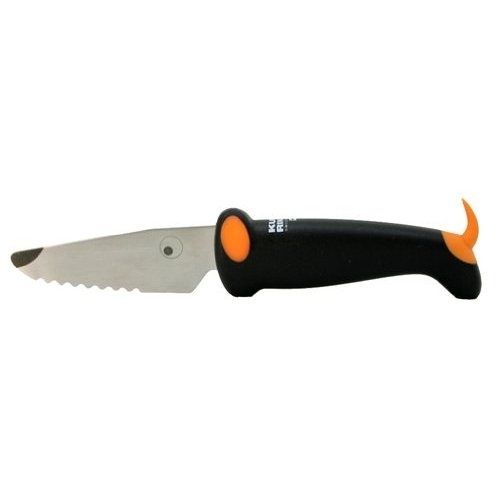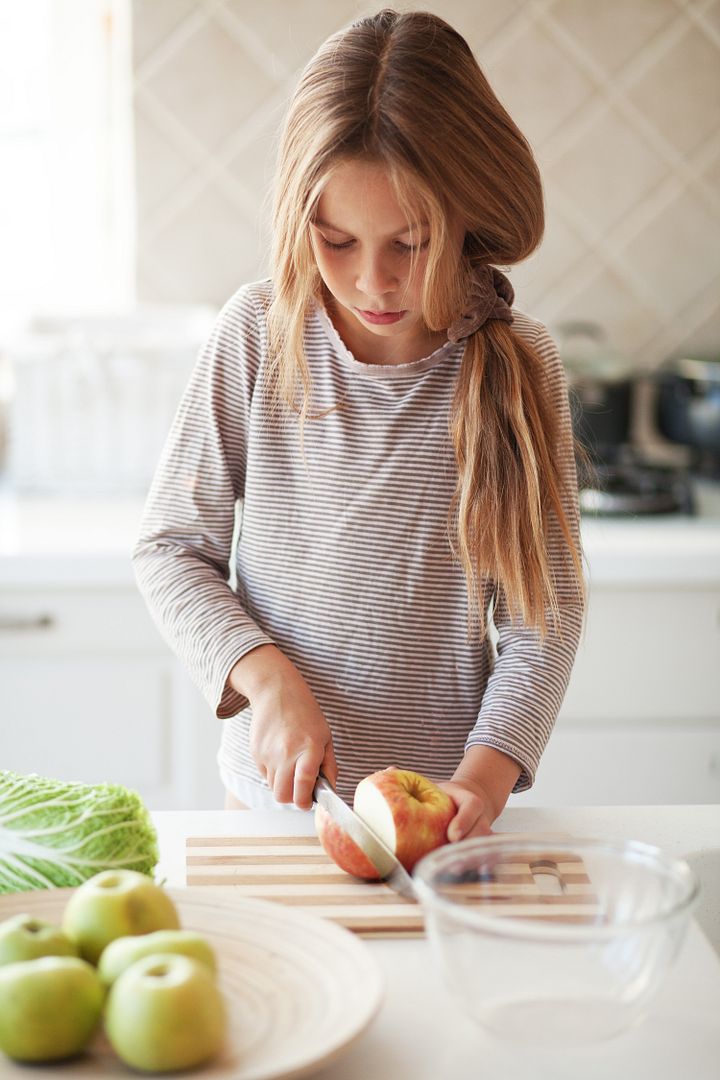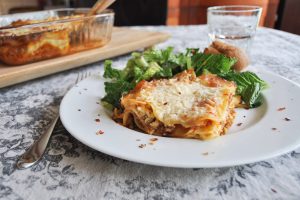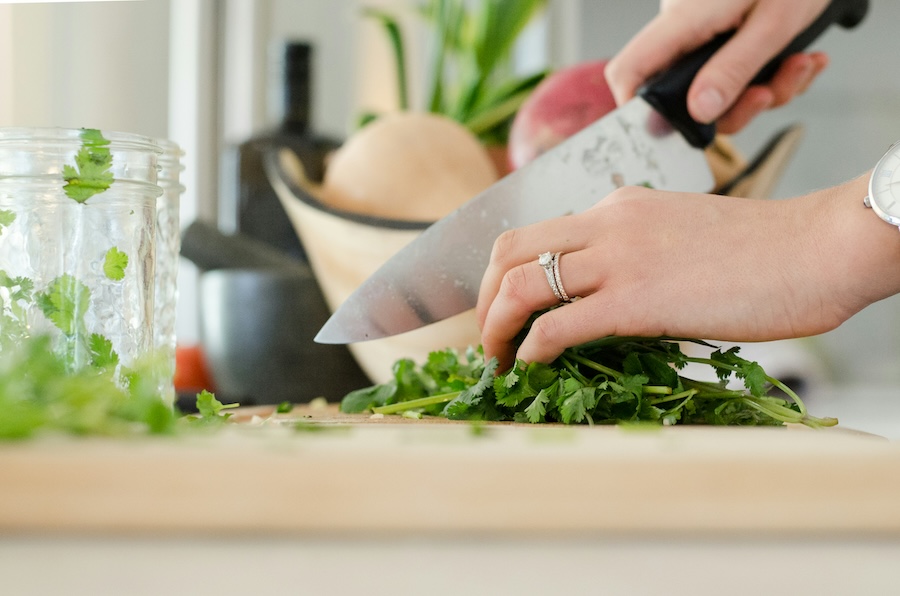There’s been a lot of discussion lately about the kinds of life milestones that our kids might be missing due to the over-parenting phenomenon. Like navigating the neighborhood alone, traveling without parents, and even skills like fending for themselves in the kitchen.
Research shows that kids used to do all these things much earlier than they do today—and this may not be a good thing.
In fact, you’d think that as someone who creates recipes professionally (and who has a higher degree in child development—ack!), my kids would be in the kitchen with me all the time. But truth be told, the kitchen is like my office and, well, do you let your kids run amok in your office? I’ve made a commitment to getting over that, though, because at six and almost nine, it’s time for my kids to start learning to cook.
Really, it was time a while ago.
Whether you have a wee one or you’re starting a little late like me and need to work your big kids up to sautéing on the stove, I’ve put together three easy things your kids can do to help cook dinner (yes, the whole dinner!) by age or experience level. Let them work through these tasks with you by their side and, once they’ve mastered them, they can make dinner for you one day.
Or at least for themselves so that you take the night off of cooking.
CMP is an Amazon and rstyle affiliate
Related: Getting kids excited to help in the kitchen: 5 tips we swear by!
Kitchen Skills for Kids by Age
Mixing and Measuring: Beginner, ages 2+

Measuring and stirring might not seem like all that significant a task, but it’s an absolutely perfect way to get younger kids or newbie cooks in the kitchen.
Giving kids something to measure and stir stations them in the kitchen, which is really the main goal here. While standing by your side, kids get the opportunity to see, smell, and touch ingredients and get an overall sense of how a meal comes together.
These sensory observations go a along way to build kids’ understanding of food and cooking. They are especially helpful in getting kids to try new veggies because, well, when you’re 3 — or even 12 — cauliflower is a lot more appealing when you’ve had a chance to work with it before it’s suddenly plopped in front of you with a directive to just eat it.
Tips:
1. When mixing and measuring with little ones, feel free to give them a separate set of ingredients so that their lack of precision won’t mess up your recipe.
2. Really small kids can even be given ingredients that aren’t in your recipe at all; when my kids were very young I gave them measuring cups, spoons and flour, dry beans, and orzo no matter what I was making. It worked every time.
3. If you have older kids, even those who have moved on to more complicated cooking tasks, measuring is a great way to engage their math skills. You can hand over the recipe and have them work out measurements or conversions on their own. Or do what I plan to do and make things a bit more complex, like telling a child you need 3/4 cup of flour plus another 1/4 cup. Then, he can practice adding fractions.
Chopping: intermediate, ages 5+

Knife skills are the most essential cooking skill. Not only can you not cook without knowing how to chop, but doing it the right way saves time and most importantly, it keeps you safe.
I get why many parents are scared to hand over a real knife to their kids but, when done properly, it can be a safe and manageable task for little ones as young as five provided they’re proficient in fine motor skills and are good at following instructions; you know your child best and should use your discretion.
We’ve even got a helpful primer for you right here:
Tips:
1. Always stay by a child’s side when they’re chopping by themselves, even if they’re older. This is not the task you hand over to the kids so that you can do a load of laundry or finish those last work emails. And, yes, it means that dinner prep may run long, so maybe you limit teaching time to the weekends? Eventually, though, it will pay off when you can prep side-by-side with your skilled sous chef.
2. Set ground rules.
This is where good listening is critical! Some ground rules that I suggest include: Only grown ups are allowed to get and carry knives; there is no chopping without an adult present; and they can only use the knife assigned to them by you. You know your child best, so feel free to modify or add to these rules.
Just be sure the list is age-appropriate, manageable, and reasonable. Overdoing it with rules to manage your own anxiety might backfire!

3. Know how to chop properly yourself.
You can’t teach a child how to use a kitchen knife safely if you don’t know how to yourself. Our friends at The Kitchn have a good overview on how to learn basic knife skills (above). I encourage you to read and watch to make sure you’re chopping properly—or at least safely. You can also search the site for more specific instructions like how to chop carrots.
One of the most important tips: If you know how to chop properly—as the how-to video will remind you—you know that the sharp tip of your knife should never leave the cutting board. Instead of lifting the whole knife up and down, which is instinctual but dangerous, you want to teach your little ones to lift and lower the handle only, pushing away from their body.

4. Start with a knife designed for kids.
Over the years, we’ve found plenty of great kitchen knives designed specifically for kids that are sharp enough to cut vegetables, but not little fingers. We like the kids kitchen tools made by Kuhn Rikon and also Curious Chef, both available through our affiliate Amazon or at kitchen stores pretty widely.
5. Make sure the knife is sharp. Yes, really.
It may be counterintuitive, but sharp knives are safer. You have to push dull knifes much harder to get the job done, which increases the likelihood of cuts and slips.
Then, when your child is ready to move on from their kids knife, outfit them with a sharp knife fitted to their hand. Most little ones seem comfortable working with a 6-8” paring knife.

6. Teach a proper knife grip.
When it comes to safety, the proper grip on your knife is as important as proper cutting technique. The folks at Serious Eats have a guide on how to hold a knife, complete with multi-angle pictures that demonstrate several grips.
7. Use a large, clean cutting board.
Use a cutting board that is bigger than you think you need to give kids ample space. Also, make sure that it’s clear. As they chop, transfer veggies to a bowl and debris to the garbage so that nothing gets in their way or trips them up.

8. Stabilize whatever you’re chopping.
Always start chopping by creating a flat surface that can rest firm on the cutting board. So, for example, when chopping an onion, cut it in half first so that the cut side down can rest on the board and keep it from wobbling under the knife.
Note: If your kid is not ready to use a knife—or you’re not ready to take them there—it’s okay. I get it. There are plenty of other tools that kids can use to help prep meals. Consider investing in an inexpensive mini chop, an egg slicer (that you can use for more than just eggs), some kitchen shears, or just have them use the blender or a vegetable peeler. A spiralizer is always fun, too!
Cooking on the Stove: advanced, ages 8+

As with chopping, I understand that it can be nerve wracking to let your child near an open flame on the stove. And, honestly, if your child isn’t yet coordinated or able to follow careful, detailed instructions, they may not be ready. You need to go with your gut here.
Many of the same ground rules that apply to using a knife also apply to cooking on the stove, especially the one about not cooking without you by their side, at least in the beginning.
To start, find just one or two things that your kids can do easily on the stove, like scramble eggs and make rice (which is added to cold water before bringing it to a boil), and stick with them. Stay by their side until you’re sure they have a handle on things before you move on to doing some other kitchen task nearby as they cook.
Tips:
1. The main thing when teaching children to use the stove is to ensure that they aren’t having to manage hot liquids or fats before they’re able. Consider that while cooking pasta may be one of the simplest cooking tasks for adults, I’d rather my kids scramble eggs—that big pot of boiling water could be asking for trouble.
2. I also avoid giving them any task that involves a pan full of hot oil. There are just too many other helpful things that kids can do in the kitchen with less risk.
3. Other key safety tips including pulling back long hair and rolling up sleeves; clearing the stove area before starting; never leaving food unattended or cooking utensils resting in a hot pot or pan. And always, always use potholders and oven mitts.
4. It may seem like a minor thing, but be sure to teach kids to stand back as they turn on the stove and to ensure that the stove is turned off when they are done. Actually, that’s not all that minor!

If just thinking about handing over a knife or letting your child manage a pan on the stove gives you hives, you’re probably not ready. It’s okay: no judgments here! But do consider working your way up to it.
In addition to mixing and measuring, kids of all ages can rinse, drain (so long as the water isn’t too hot), knead, spread, roll, rub, and, of course, help set the table and load the dishwasher. It’s why so many parents love baking with their kids and find that it’s a great place to start before actual cooking.
The truth is, anything that gets kids helping in the kitchen and, at the very least, watching you cook, is a step in a healthier direction. Good luck, and let us know how it goes for you!






My daughters started cracking eggs at 2 years old and its still their favorite kitchen job. I just have them crack eggs into a separate bowl so I ccan fish out any rouge shell bits before using the eggs.
That’s so smart, Lacey! And, having one kid who loves anything and everything messy, I can imagine this being the perfect starter job in the kitchen.